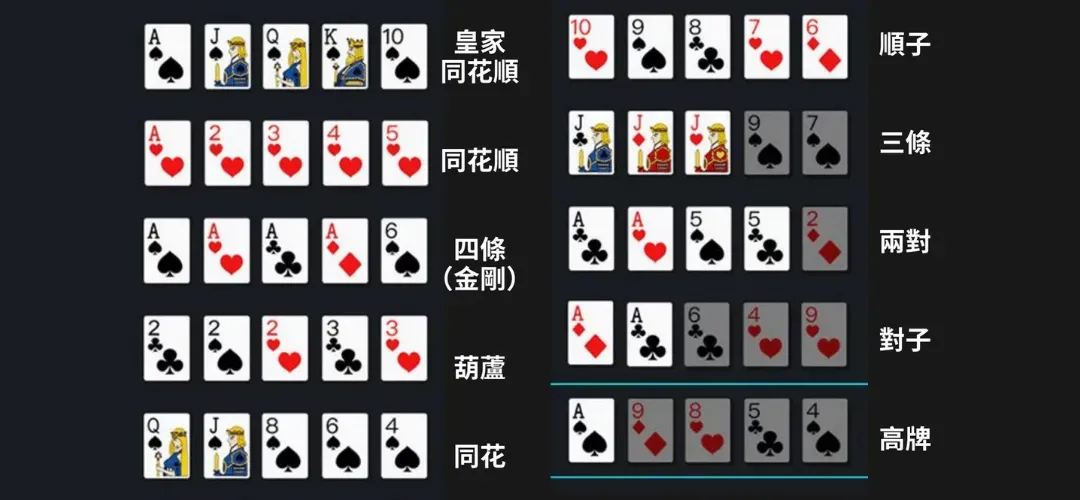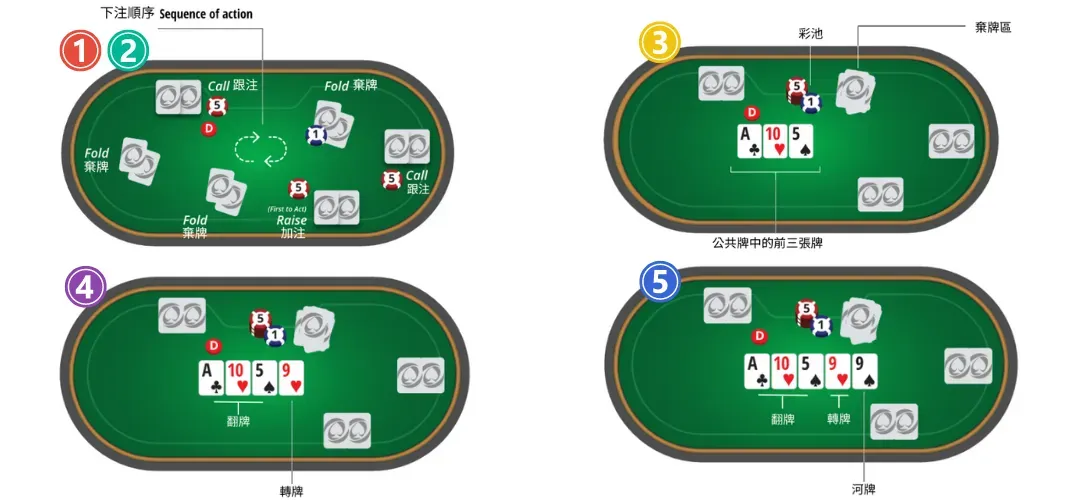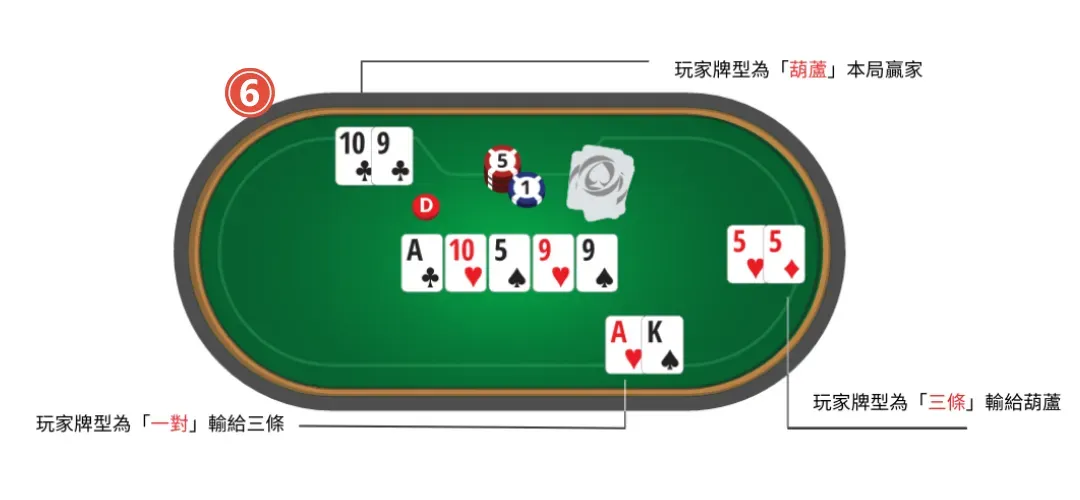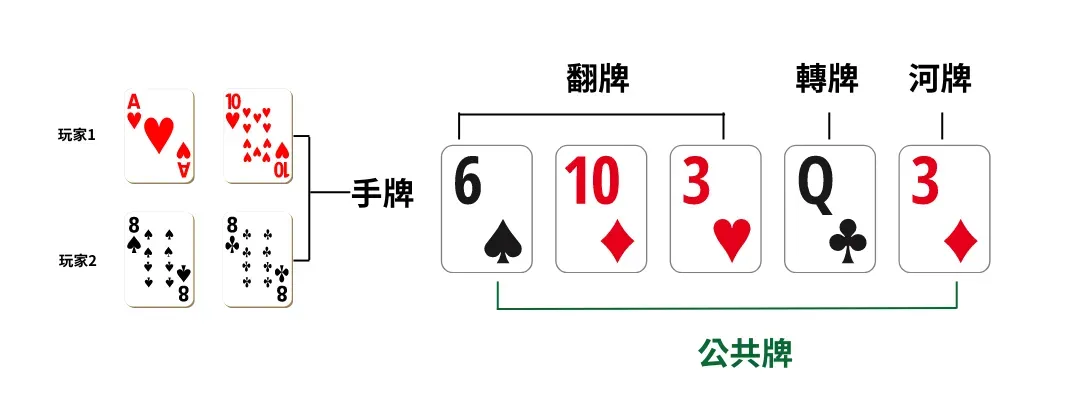As one of the most popular poker games in the world, Texas Hold'em draws the attention of countless players.
Whether you're a poker enthusiast or brand new to the game, this article offers a fun and easy introduction to Texas Hold'em and invites you to begin your journey into the world of poker mastery.
1.Have You Heard of Texas Hold'em?
Texas Hold'em, often shortened to Hold'em, is a poker game that originated in the state of Texas, USA.
- It gained popularity in the early 20th century.
- By the 1970s, it entered casinos and gradually became one of the most popular poker games worldwide.
- Texas Hold'em blends luck and strategy, requiring players to make decisions based on their hole cards and opponents' actions.
The Global Appeal of Texas Hold'em
- The WSOP Main Event draws top players from around the world.
- In 2019, a total of 8,569 players entered, each paying a $10,000 buy-in.
- The champion can win tens of millions of dollars and earn legendary status in the poker world.

2.How to Win in Texas Hold'em?
The main objective in Texas Hold'em is to win the pot. The pot refers to the total amount of chips wagered by all players in a hand.
In Taiwan, it's common to hear players say things like "I'm going for the pot," "steal the pot," or "bet a full pot." That "pot" simply means the prize pool.
There are two ways to win the pot:
- Winning at Showdown
At the final showdown, if your best five-card hand (made from your two hole cards plus the five community cards) is stronger than any other remaining player’s hand, you win the pot.
- Forcing Opponents to Fold
You can also win by betting or raising in a way that causes all other players to fold. If you're the last player remaining, you win the pot automatically.
3.How Many Players Do You Need to Play Texas Hold'em?
Texas Hold'em can't be played alone. A standard table requires a minimum of 2 and a maximum of 10 players.
- Minimum 2 players – Heads-Up: This is a one-on-one format that heavily tests both skill and psychology.
- Maximum 10 players – Full Ring: With a full table, the pot tends to grow quickly, and players often play more hands to compete for bigger rewards.
- Common format: 6-Max: With up to 6 players, the game moves faster and demands sharper skills and mental focus. It's a favorite among professional players.
A two-player match is called heads-up, which means one-on-one. This format is highly demanding and puts both players’ poker skills to the test.
When the table is full, it's known as a full-ring game. In this setup, the pot tends to grow quickly, encouraging players to enter more hands and compete for bigger rewards.
There’s also a popular format called 6-max, where up to six players take part. It strikes a balance between pace and action, allowing more hands and strategic play. This format is especially favored by professional players.
4.What Do You Need to Play Texas Hold'em?
- Poker Table: Oval-shaped, typically seats up to 10 players.
- Standard 52-Card Deck: No jokers included.
- Chips: Used in place of cash for betting.
- Cut Card: Prevents the bottom card from being seen or marked.
- Dealer Button: Indicates the current dealer position.
- All-in Triangle: Used when a player goes all-in.
- Card Protector: Keeps hole cards secure and prevents them from being accidentally mucked.
Other Equipment: Depending on the game or tournament, additional items may include a dealing shoe (to hold cards), shuffler (for faster shuffling), and a timer (to manage betting time).

5. Texas Hold'em Hand Rankings and Winning Rules
In Texas Hold'em, each hand ranking has a different level of strength. Understanding these rankings helps players make better strategic decisions.
Below is the list of Texas Hold'em hand rankings from strongest to weakest:
- Royal Flush: A, K, Q, J, 10 of the same suit
- Straight Flush: Any five consecutive cards of the same suit
- Four of a Kind: Four cards of the same rank
- Full House: Three cards of one rank plus a pair
- Flush: Five cards of the same suit, not in sequence
- Straight: Five consecutive cards of any suits
- Three of a Kind: Three cards of the same rank
- Two Pair: Two separate pairs
- One Pair: One pair
- High Card: None of the above combinations, highest card decides the winner

6.Texas Hold'em Betting Flow
- Pre-Flop:
- Each player is dealt 2 hole cards, visible only to themselves.
- The player to the left posts the Small Blind, and the next player posts the Big Blind.
- First betting round begins (players can call, raise, or fold).
- Flop:
- Three community cards are dealt face up on the table.
- Second round of betting follows.
- Turn:
- A fourth community card is dealt.
- Third round of betting begins.
- River:
- A fifth and final community card is dealt.
- Final betting round takes place.
- Showdown:
- Remaining players reveal their cards.
- The best hand wins the pot.
- If hands are tied, the pot is split.


7.Texas Hold'em Side Bet – AA Side Bet
- AA Side Bet: Players can optionally wager on whether their two hole cards plus the first three community cards (the flop) will form a pair of Aces or a stronger hand.
- This side bet is calculated independently from the main game and adds extra excitement and variety to the gameplay.
8.Texas Hold'em Rules Overview
Texas Hold'em is a popular poker game with simple rules that are easy to learn. Here are the basic rules:
- Each player is dealt two private hole cards, visible only to themselves.
- The dealer deals cards clockwise, and the dealer position rotates one seat to the left after each hand.
- At the beginning of each round, the first and second players to the left of the dealer post the small blind and big blind, respectively.
- After hole cards are dealt, the first round of betting begins with the third player to the left of the dealer (Pre-Flop betting), and continues clockwise.
- Once the first betting round ends, the dealer reveals the first three community cards (the Flop), which are shared by all players.
- The second round of betting (Flop betting) begins with the player in the small blind position.
- After the second round, a fourth community card (the Turn) is dealt, followed by the third round of betting (Turn betting).
- Then the fifth and final community card (the River) is dealt, followed by the last round of betting (River betting).
- After the final betting round, any remaining players enter the Showdown. Players reveal their hole cards and form the best five-card hand using any combination of their hole cards and the five community cards. The player with the best hand wins the pot.

Key Tip: What Does "All In" Mean? "All in" refers to a special situation in poker where a player bets all of their remaining chips. If a previous player places a bet larger than what the next player has, the shorter-stacked player can choose to go all in to stay in the hand. Once a player is all in, they remain in the hand until the showdown, regardless of the betting that follows. However, if they win, they can only claim the portion of the pot that matches the amount of their all-in bet. |
9.Texas Hold'em Tips: Basic, Advanced, and Practical
Texas Hold'em is a popular poker game where players must decide whether to bet, raise, or fold based on their own cards and their opponents' actions.
To improve your chances of winning, it’s important to learn and apply some fundamental strategies.
Practical Texas Hold'em Tips
Before the flop, players should decide whether to enter the pot based on their hole cards and table position.
In general, the stronger your hand and the better your position, the higher your chances of playing profitably. Here are some specific tips:
- Pre-Flop Hand Selection
- The later your position, the more information you have, allowing you to widen your range.
- Premium hands like AA, KK, QQ, JJ, and suited AK should be played aggressively with raises.
- Post-Flop Evaluation
- Carefully assess the pot odds and potential threats on the board.
- Always pay attention to your opponents’ actions and betting patterns.
Advanced Texas Hold'em Tips
Loose vs Tight Play
Loose players play a wide range of hands, even with weaker cards or in poor positions.
Tight players are more selective, entering the pot only with strong hands or in favorable positions.
- Advantages of Tight Play: It improves win rates and reduces the risk of losing chips.
Disadvantages: You play fewer hands, which can limit your opportunities to win.
Aggressive vs Passive Play
Aggressive and passive refer to betting behavior. Aggressive players tend to raise and apply pressure. Passive players tend to call rather than raise.
- dvantages of Passive Play: It minimizes risk and helps conserve chips.
Disadvantages: It’s harder to win large pots and easier to be outplayed.
Beginner Texas Hold'em Tips
Entering the Pot
- The stronger your hole cards, the more likely you should play.
- Hands like AA, KK, QQ, JJ, and TT are top pairs and can be played confidently from any position.
- Strong suited high cards like AK, AQ, AJ, KQ, and KJ are also worth playing, especially from late position.
Betting Strategy
- When the board is favorable, consider raising.
If you have a flush, straight, full house, or other strong hands, raise to build the pot and earn more chips. - When the board is unfavorable, consider folding.
If your hand is weak or your opponent shows obvious strength, folding can help minimize losses. - Watch your opponents closely to read their strength.
Big bets might mean strong hands, while quick folds can suggest weak cards.
Psychological Control
- Keep your emotions in check.
Texas Hold'em is a mental game, and staying calm helps you make better decisions. - If you're feeling tilted or emotional, take a break.
Stepping away from the table can help you reset before continuing.
Examples:
- You have AA in the small blind. You should raise since you have the strongest hand and a decent position.
- You have 7-2 in the big blind. You should fold—it's one of the weakest starting hands, and your position isn’t great.
- You’re on a flush draw after the flop. Consider betting or raising, since you have potential to hit a strong hand.
- Your opponent makes a big bet on the river. Be cautious—they may be holding a very strong hand.
10. Texas Hold'em Starting Hand Win Rates
The winning odds of starting hands in Texas Hold'em depend on several factors, including the number of opponents, your table position, and your opponents' potential hands.
Below are the approximate win rates for some common starting hands, based on typical scenarios in No-Limit Texas Hold'em against multiple players:
- A-A (Pocket Aces): Around 85% win rate
- K-K (Pocket Kings): Around 82% win rate
- Q-Q (Pocket Queens): Around 79% win rate
- J-J (Pocket Jacks): Around 77% win rate
- 10-10 (Pocket Tens): Around 75% win rate
- A-K Suited: Around 67% win rate
- A-Q Suited: Around 65% win rate
- A-J Suited: Around 64% win rate
- K-Q Suited: Around 63% win rate
- A-K Offsuit: Around 60% win rate
11. Common Texas Hold'em Terms
| Terms | Explain |
|---|---|
| Ante | A small forced bet that all players must post before the cards are dealt is called the ante. |
| Big Blind | A big blind is a mandatory bet posted by the player to the left of the dealer, usually twice the size of the small blind. |
| Small Blind | A small blind is a mandatory bet posted by the player directly to the left of the dealer, typically half the size of the big blind. |
| Call | A call is matching the amount of the previous player's bet. |
| Raise | A raise is increasing the amount of the previous bet. |
| All-in | The act of betting all your remaining chips is called all-in. |
| Fold | The act of discarding your hand and exiting the current round is called fold. |
| Check | Choosing not to bet, which is only allowed if no bet has been made, is called check. |
| Preflop | All betting rounds that occur before the community cards are dealt are referred to as pre-flop. |
| Flop | The first set of community cards in Texas Hold'em, consisting of three cards dealt after the pre-flop round, is called the flop. |
| Turn | The second round of community cards in Texas Hold'em, consisting of one card dealt after the flop, is called the turn. |
| River | The third round of community cards, also one card dealt after the turn, is called the river. |
| Pot | The total amount of all bets placed in a hand is called the pot. |
| Split pot | When two or more players have equally strong hands, the pot is split between them. |
| Under the Gun | The UTG position is the first player to act in the betting round, seated directly to the left of the big blind. |
| Trips | A hand containing three cards of the same rank is called three of a kind. |
| Stack | The total amount of chips a player currently has is called their stack. |
| Showdown | The showdown is when players reveal their hands to determine the winner. |
| Dealer | The dealer is the person responsible for dealing the cards. |
12.How to Play Texas Hold'em Online
At many online entertainment platforms, such as RG Casino, you can find the following Texas Hold'em options:
- Live Dealer Texas Hold'em
- Platforms like OB Live and PM Live offer real-time video dealers for interactive gameplay.
- Enjoy an immersive experience as you compete with other online players and feel the atmosphere of a real poker table.
- Electronic Texas Hold'em
- Available on platforms like PM Chess and Golden Chess.
- These games are faster-paced with no live dealer, using automated dealing and payouts—perfect for beginners looking to practice.

Begin Your Journey to Master Texas Hold'em
The charm of Texas Hold'em lies in its perfect blend of strategy, mindset, and luck. Whether you're a beginner or a seasoned player, you'll find excitement and challenge in every hand.
- Beginners should first focus on learning basic hand rankings, position strategy, and betting rules.
- Intermediate players need to pay attention to playing tight or loose, their level of aggression, and reading opponents’ behavior.
- Advanced players rely on precise calculations, psychological tactics, and adaptability to gain an edge.
If you’re ready to try online Texas Hold’em, platforms like RG Casino offer a legal and exciting way to test your skills. Remember to play responsibly and enjoy the thrill and satisfaction of every strategic battle at the table.




